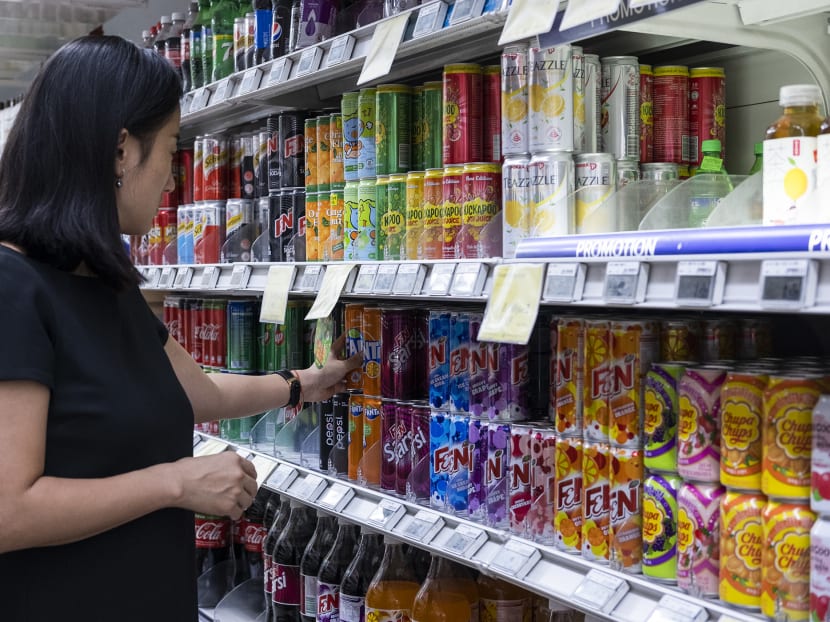War on sugar: High-sugar packaged drinks to come with health labels, advertising ban for the least healthy
SINGAPORE — Sometime in the next few years, pre-packaged sugar-sweetened drinks that are deemed “less healthy”, including certain sodas, juices and teas, will come with colour-coded labels to give consumers a quick indication of how much sugar they contain.

In the future, pre-packaged sugar-sweetened drinks will have colour-coded labels to show the health grade of those drinks.
SINGAPORE — Sometime in the next few years, pre-packaged sugar-sweetened drinks that are deemed “less healthy”, including certain sodas, juices and teas, will come with colour-coded labels to give consumers a quick indication of how much sugar they contain.
These labels will show the health grade of the drink, which will be based on several factors, but mainly the level of added sugar it contains.
And in a move to limit public exposure to the least healthy drinks, the Ministry of Health (MOH) will be banning advertisements of drinks that receive the poorest grade on all local mass media platforms, including on websites and social media.
The ministry said that the advertising ban will be a world's first — other countries have only gone so far as to limit such adverts on channels and time-belts that target children.
Drinks made on the spot such as coffee, tea or bubble tea, whose sugar levels may be determined by customers, are not covered under the proposed measures. However, Senior Minister of State for Law and Health Edwin Tong told reporters on Thursday (Oct 10) that they will eventually come under MOH's scrutiny too.
“We start with (packaged drinks) but we won’t end there. Let me make that clear… the objective is sugar, in whatever form,” he said, noting that packaged drinks are the first target because they are “the biggest, lowest-hanging fruit”.
“We are after the sugar concentration, so of course we are going into freshly-prepared beverages as well.”
MOH and the Health Promotion Board (HPB) will conduct consumer focus group discussions on the design of the nutrition labels and obtain feedback from drink manufacturers and advertising firms on the implementation details of the two measures.
More details on these two measures will be shared in 2020, the MOH said.
The MOH decided on these moves eight months after completing an eight-week public consultation earlier this year on how Singaporeans can reduce their sugar intake from ready-to-drink products in cans, packets, cartons and bottles, as well as drinks that require dilution from cordials, concentrates or powders.
There were four proposals that MOH put forth in its consultations, and these were the two that received the highest public support.
The other two proposals were to roll out a nationwide ban on the sale of higher-sugar prepackaged drinks and a sugar tax on the soft drinks industry.
The MOH said it will “continue to explore an excise duty or a ban, which are more complex measures that require further study”.
Speaking at the 17th Singapore Health and Biomedical Congress, Mr Tong said the measures seek to “shift demand and consumption patterns towards the healthier options” on shop shelves.
Mr Tong highlighted in particular drinks with sugar levels of more than 10 per cent, which translates to about five teaspoons per 250ml.
“I am encouraged by the rapid growth in the healthier sugar-sweetened beverage segment. However, there remains a ‘sticky’ segment of drinks with a sugar level of more than 10 per cent and that has not come down over the years,” Mr Tong said.
More than half of Singaporeans’ sugar consumption – averaging 12 teaspoons a day – still come from these sources, he added, as he noted that drinking an additional 250ml serving of sugar-sweetened drinks a day increases the risk of diabetes by up to 26 per cent.
“With advances in food technology on top of everything else, I am confident that companies can reformulate them to healthier sugar-sweetened beverages,” said Mr Tong, adding that the Government will support reformulation efforts through grants and incentives, and will provide the industry with “sufficient time” to make these changes before measures kick in.
WHAT SINGAPOREANS SAID
During its public consultation, the MOH surveyed more than 3,700 members of the public:
84 per cent supported mandatory front-of-pack labels
71 per cent supported advertisement prohibition
65 per cent supported a sugar tax, to encourage manufacturers to reformulate and reduce the sugar levels in their drinks
48 per cent supported a ban of higher-sugared drinks.
Meanwhile, 56 industry representatives who were also consulted – 21 of whom were drink makers, importers or distributors – voiced particularly strong views against the excise duty and the ban.
These industry players said a tax would likely be passed down to consumers in the form of higher prices and they noted that there is limited evidence to show that it would be effective in improving population-level health outcomes.
Some representatives also pointed out that it would create an uneven playing field, as consumers could substitute sugary drinks with other sugary food and drinks that are not taxed, such as bubble tea and coffees and teas made on the spot.
And while a ban would be the most effective measure towards achieving the Government’s goal, some industry players felt that it is too harsh and would be disproportionate to the harms of pre-packaged sugar-sweetened beverages.
Again, they noted, consumers can easily substitute the banned drinks by loading sugar on freshly prepared ones.
NAILING DOWN THE DETAILS
Having decided on the two measures to be rolled out, the MOH’s next steps are to start another round of consultations to determine how to grade sugar-sweetened beverages — what level of sugar, for example, would be deemed “less healthy” or “very unhealthy”.
There will likely be four or five grades, similar to the Nutri-Score model implemented in France, the MOH said, but said details have yet to be ironed out.
As a gauge, when it first announced its four proposals last December, drinks containing an average of 5.5 teaspoons of sugar per 250ml were referred to as “higher-sugared” drinks, while drinks with an average of four teaspoons of sugar per 250ml were referred to as “medium-sugared” drinks.
These two categories made up about 55 per cent of all pre-packaged, sugar-sweetened drinks sold here, according to data provided last year.
Meanwhile, the HPB currently hands out the "Healthier Choice" symbol to drinks containing no more than 6 per cent of sugar, which translates to three teaspoons or less in a 250ml portion.
In 2017, the Government received pledges from seven major beverage producers, cornering 70 per cent of the pre-packaged drinks market here, to cut the sugar content in their drinks to no more than six teaspoons per 250ml.
They are Coca-Cola, F&N, Malaysia Dairy Industries, Nestle, PepsiCo, Pokka and Yeo Hiap Seng.
Drinks that remain at the highest end of the spectrum today contain seven to eight teaspoons of sugar per 250ml. Some fruit juices, yoghurts and cultured milk drinks fall under this category.
The MOH said it will likely announce the criteria for its grading by June next year, during which it could share a more definite timeline on when the measures could be rolled out.
It, however, noted that it will take at least one year from that point before consumers will get to see the colour-coded grades on the labels of drinks with higher sugar content, and only those assigned with the top two to three grades will be required to slap on the new label.
DO LABELS AND ADVERTISING BANS WORK?
The MOH said more than 30 countries have adopted front-of-pack labels to help promote healthier diets, and studies among these countries have shown that they help consumers make informed, healthier choices.
In Chile, which adopted mandatory "high in sugar" labels from 2016, for instance, there was a 50 per cent reduction in the number of drinks carrying the "high in sugar" labels in eight months, while purchases of higher-sugar drinks dropped by 25 per cent within one-and-a-half years.
The MOH added that since the HPB launched the "Healthier Choice" symbol programme, which is a voluntary one, the market share of drinks with the symbol has risen from 30 per cent in 2012 to 44 per cent as of March 2018.
Advertising prohibitions are also known to be effective in reducing sales of unhealthy food and drinks and spurring reformulation, although the industry would prefer to continue with the current self-regulatory approach, the MOH said.
It cited a global study across 79 countries, which found that statutory regulation on junk food advertisements had reduced junk food sales by up to 9 per cent per capita. In countries without such advertising restrictions, junk food sales increased by some 14 per cent.
A study on over 60 companies in South Korea found that advertising regulations had also nudged up to 41 per cent of affected companies to reduce their sugar content, it added.








